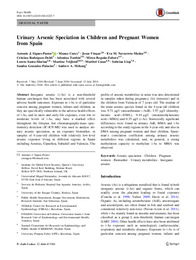Por favor, use este identificador para citar o enlazar este ítem:
https://hdl.handle.net/11000/30792Registro completo de metadatos
| Campo DC | Valor | Lengua/Idioma |
|---|---|---|
| dc.contributor.author | Signes-Pastor, Antonio Jose | - |
| dc.contributor.author | Carey, Manus | - |
| dc.contributor.author | Vioque, Jesús | - |
| dc.contributor.author | Navarrete-Muñoz, Eva María | - |
| dc.contributor.author | Rodríguez-Dehli, Ana Cristina | - |
| dc.contributor.author | Tardon, Adonina | - |
| dc.contributor.author | Begoña-Zubero, Miren | - |
| dc.contributor.author | SANTA MARINA, LORETO | - |
| dc.contributor.author | Vrijheid, Martine | - |
| dc.contributor.author | Casas, Maribel | - |
| dc.contributor.author | Llop, Sabrina | - |
| dc.contributor.author | González Palacios, Sandra | - |
| dc.contributor.author | Meharg, Andrew A. | - |
| dc.contributor.other | Departamentos de la UMH::Salud Pública, Historia de la Ciencia y Ginecología | es_ES |
| dc.contributor.other | Departamentos de la UMH::Patología y Cirugía | es_ES |
| dc.date.accessioned | 2024-01-26T22:25:34Z | - |
| dc.date.available | 2024-01-26T22:25:34Z | - |
| dc.date.created | 2016-07-13 | - |
| dc.identifier.citation | Expo Health. 2017;9(2):105-111 | es_ES |
| dc.identifier.issn | 2451-9685 | - |
| dc.identifier.issn | 2451-9766 | - |
| dc.identifier.uri | https://hdl.handle.net/11000/30792 | - |
| dc.description.abstract | Inorganic arsenic (i-As) is a non-threshold human carcinogen that has been associated with several adverse health outcomes. Exposure to i-As is of particular concern among pregnant women, infants and children, as they are specifically vulnerable to the adverse health effects of i-As, and in utero and early-life exposure, even low to moderate levels of i-As, may have a marked effect throughout the lifespan. Ion chromatography-mass spectrometry detection (IC-ICP-MS) was used to analyse urinary arsenic speciation, as an exposure biomarker, in samples of 4-year-old children with relatively low-level arsenic exposure living in different regions in Spain including Asturias, Gipuzkoa, Sabadell and Valencia. The profile of arsenic metabolites in urine was also determined in samples taken during pregnancy (1st trimester) and in the children from Valencia of 7 years old. The median of the main arsenic species found in the 4-year-old children was 9.71 lg/l (arsenobetaine—AsB), 3.97 lg/l (dimethylarsinic acid—DMA), 0.44 lg/l (monomethylarsonic acid—MMA) and 0.35 lg/l (i-As). Statistically significant differences were found in urinary AsB, MMA and i-As according to the study regions in the 4-year-old, and also in DMA among pregnant women and their children. Spearman’s correlation coefficient among urinary arsenic metabolites was calculated, and, in general, a strong methylation capacity to methylate i-As to MMA was observed. | es_ES |
| dc.format | application/pdf | es_ES |
| dc.format.extent | 7 | es_ES |
| dc.language.iso | eng | es_ES |
| dc.publisher | Springer | es_ES |
| dc.rights | info:eu-repo/semantics/openAccess | es_ES |
| dc.rights | Attribution-NonCommercial-NoDerivatives 4.0 Internacional | * |
| dc.rights.uri | http://creativecommons.org/licenses/by-nc-nd/4.0/ | * |
| dc.subject | Arsenic speciation | es_ES |
| dc.subject | Children | es_ES |
| dc.subject | Pregnant women | es_ES |
| dc.subject | Biomarker | es_ES |
| dc.subject | Urinary metabolites | es_ES |
| dc.subject | Inorganic arsenic | es_ES |
| dc.title | Urinary Arsenic Speciation in Children and Pregnant Women from Spain | es_ES |
| dc.type | info:eu-repo/semantics/article | es_ES |
| dc.relation.publisherversion | https://doi.org/10.1007/s12403-016-0225-7 | es_ES |

Ver/Abrir:
Urinary Arsenic Speciation in Children and Pregnant Women.pdf
888,71 kB
Adobe PDF
Compartir:
 La licencia se describe como: Atribución-NonComercial-NoDerivada 4.0 Internacional.
La licencia se describe como: Atribución-NonComercial-NoDerivada 4.0 Internacional.
.png)